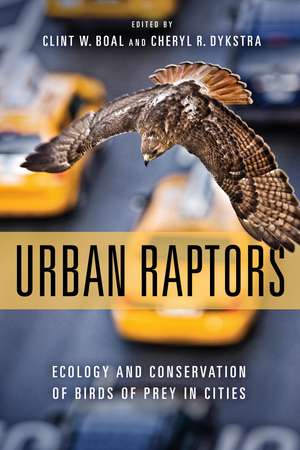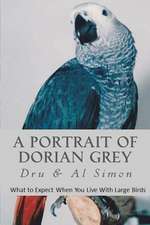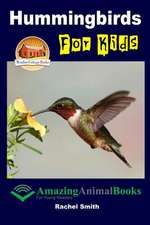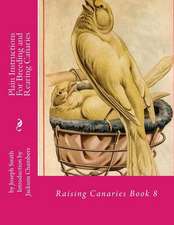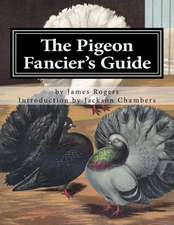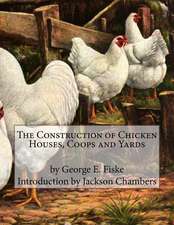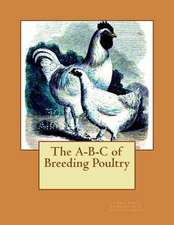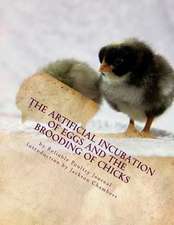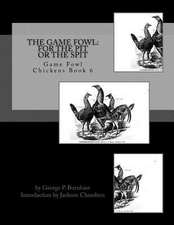Urban Raptors: Ecology and Conservation of Birds of Prey in Cities
Editat de Clint W. Boal, Cheryl R. Dykstraen Limba Engleză Paperback – 11 iun 2018
Raptors are an unusual success story of wildness thriving in the heart of our cities—they have developed substantial populations around the world in recent decades. But there are deeper issues around how these birds make their urban homes. New research provides insight into the role of raptors as vital members of the urban ecosystem and future opportunities for protection, management, and environmental education.
A cutting-edge synthesis of over two decades of scientific research, Urban Raptors is the first book to offer a complete overview of urban ecosystems in the context of bird-of-prey ecology and conservation. This comprehensive volume examines urban environments, explains why some species adapt to urban areas but others do not, and introduces modern research tools to help in the study of urban raptors. It also delves into climate change adaptation, human-wildlife conflict, and the unique risks birds of prey face in urban areas before concluding with real-world wildlife management case studies and suggestions for future research and conservation efforts.
Boal and Dykstra have compiled the go-to single source of information on urban birds of prey. Among researchers, urban green space planners, wildlife management agencies, birders, and informed citizens alike, Urban Raptors will foster a greater understanding of birds of prey and an increased willingness to accommodate them as important members, not intruders, of our cities.
A cutting-edge synthesis of over two decades of scientific research, Urban Raptors is the first book to offer a complete overview of urban ecosystems in the context of bird-of-prey ecology and conservation. This comprehensive volume examines urban environments, explains why some species adapt to urban areas but others do not, and introduces modern research tools to help in the study of urban raptors. It also delves into climate change adaptation, human-wildlife conflict, and the unique risks birds of prey face in urban areas before concluding with real-world wildlife management case studies and suggestions for future research and conservation efforts.
Boal and Dykstra have compiled the go-to single source of information on urban birds of prey. Among researchers, urban green space planners, wildlife management agencies, birders, and informed citizens alike, Urban Raptors will foster a greater understanding of birds of prey and an increased willingness to accommodate them as important members, not intruders, of our cities.
Preț: 384.32 lei
Nou
Puncte Express: 576
Preț estimativ în valută:
73.54€ • 76.99$ • 60.85£
73.54€ • 76.99$ • 60.85£
Carte disponibilă
Livrare economică 11-17 martie
Livrare express 04-08 martie pentru 50.44 lei
Preluare comenzi: 021 569.72.76
Specificații
ISBN-13: 9781610918404
ISBN-10: 1610918401
Pagini: 320
Ilustrații: one 16-page color insert, 43 photos, 7 illustratio
Dimensiuni: 152 x 229 x 23 mm
Greutate: 0.46 kg
Ediția:None
Editura: Island Press
Colecția Island Press
ISBN-10: 1610918401
Pagini: 320
Ilustrații: one 16-page color insert, 43 photos, 7 illustratio
Dimensiuni: 152 x 229 x 23 mm
Greutate: 0.46 kg
Ediția:None
Editura: Island Press
Colecția Island Press
Notă biografică
Clint W. Boal is a research wildlife biologist with the U.S. Geological Surveys Texas Cooperative Research Unit and holds a joint appointment as a professor of wildlife ecology at Texas Tech University. He has conducted research with birds of prey for over 25 years and has served as an associate editor for the Journal of Wildlife Management, Journal of Raptor Research, and, currently, the Wildlife Society Bulletin.
Cheryl R. Dykstra is an independent researcher and holds an M.S. and Ph.D. in wildlife ecology from the University of Wisconsin–Madison. She serves as editor-in-chief of The Journal of Raptor Research and has spent over two decades leading raptor research projects, including an ongoing 20-year study of urban red-shouldered hawks.
Cheryl R. Dykstra is an independent researcher and holds an M.S. and Ph.D. in wildlife ecology from the University of Wisconsin–Madison. She serves as editor-in-chief of The Journal of Raptor Research and has spent over two decades leading raptor research projects, including an ongoing 20-year study of urban red-shouldered hawks.
Cuprins
Preface
PART I: Raptors in Urban Ecosystems
Chapter 1. Urban Birds of Prey: A Lengthy History of Human–Raptor Cohabitation \ Keith L. Bildstein and Jean-François Therrien
Chapter 2. City Lifestyles: Behavioral Ecology of Urban Raptors \ Cheryl R. Dykstra
Chapter 3. Urban Raptor Communities: Why Some Raptors and Not Others Occupy Urban Environments \ Clint W. Boal
Chapter 4. Demography of Raptor Populations in Urban Environments \ R. William Mannan and Robert J. Steidl
Chapter 5. Urbanization and Raptors: Trends and Research Approaches \ Raylene Cooke, Fiona Hogan, Bronwyn Isaac, Marian Weaving, and John G. White
PART II: Urban Raptors
Chapter 6. Mississippi Kites: Elegance Aloft \ Ben R. Skipper
Chapter 7. Cooper’s Hawk: The Bold Backyard Hunter \ Robert N. Rosenfield, R. William Mannan, and Brian A. Millsap
Chapter 8. Red-shouldered Hawk: Adaptable Denizen of the Suburbs \ Cheryl R. Dykstra, Peter H. Bloom, and Michael D. McCrary
Chapter 9. Harris’s Hawks: All in the Family \ Clint W. Boal and James F. Dwyer
Chapter 10. Barred Owls: A Nocturnal Generalist Thrives in Wooded, Suburban Habitats \ Richard O. Bierregaard
Chapter 11. Powerful Owls: Possum Assassins Move into Town \ Raylene Cooke, Fiona Hogan, Bronwyn Isaac, Marian Weaving, and John G. White
Chapter 12. Burrowing Owls: Happy Urbanite or Disgruntled Tenant? \ Courtney J. Conway
Chapter 13. Peregrine Falcon: The Neighbors Upstairs \ Joel E. Pagel, Clifford M. Anderson, Douglas A. Bell, Edward Deal, Lloyd Kiff, F. Arthur McMorris, Patrick T. Redig, and Robert Sallinger
PART III: Conservation and Management
Chapter 14. Raptor Mortality in Urban Landscapes \ James F. Dwyer, Sofi Hindmarch, and Gail E. Kratz
Chapter 15. Raptor–Human Conflicts in Urban Settings \ Brian E. Washburn
Chapter 16. Raptors: Victims and Ambassadors—Raptor Rehabilitation, Education, and Outreach \ Lori R. Arent, Michelle Willette, and Gail Buhl
Chapter 17. Urban Raptor Case Studies: Lessons from Texas \ John M. Davis
Chapter 18. Management and Conservation of Urban Raptors \ David M. Bird, Robert N. Rosenfield, Greg Septon, Marcel A. Gahbauer, John H. Barclay, and Jeffrey L. Lincer
Chapter 19. Perspectives and Future Directions \ Stephen DeStefano and Clint W. Boal
Contributors
Index
PART I: Raptors in Urban Ecosystems
Chapter 1. Urban Birds of Prey: A Lengthy History of Human–Raptor Cohabitation \ Keith L. Bildstein and Jean-François Therrien
Chapter 2. City Lifestyles: Behavioral Ecology of Urban Raptors \ Cheryl R. Dykstra
Chapter 3. Urban Raptor Communities: Why Some Raptors and Not Others Occupy Urban Environments \ Clint W. Boal
Chapter 4. Demography of Raptor Populations in Urban Environments \ R. William Mannan and Robert J. Steidl
Chapter 5. Urbanization and Raptors: Trends and Research Approaches \ Raylene Cooke, Fiona Hogan, Bronwyn Isaac, Marian Weaving, and John G. White
PART II: Urban Raptors
Chapter 6. Mississippi Kites: Elegance Aloft \ Ben R. Skipper
Chapter 7. Cooper’s Hawk: The Bold Backyard Hunter \ Robert N. Rosenfield, R. William Mannan, and Brian A. Millsap
Chapter 8. Red-shouldered Hawk: Adaptable Denizen of the Suburbs \ Cheryl R. Dykstra, Peter H. Bloom, and Michael D. McCrary
Chapter 9. Harris’s Hawks: All in the Family \ Clint W. Boal and James F. Dwyer
Chapter 10. Barred Owls: A Nocturnal Generalist Thrives in Wooded, Suburban Habitats \ Richard O. Bierregaard
Chapter 11. Powerful Owls: Possum Assassins Move into Town \ Raylene Cooke, Fiona Hogan, Bronwyn Isaac, Marian Weaving, and John G. White
Chapter 12. Burrowing Owls: Happy Urbanite or Disgruntled Tenant? \ Courtney J. Conway
Chapter 13. Peregrine Falcon: The Neighbors Upstairs \ Joel E. Pagel, Clifford M. Anderson, Douglas A. Bell, Edward Deal, Lloyd Kiff, F. Arthur McMorris, Patrick T. Redig, and Robert Sallinger
PART III: Conservation and Management
Chapter 14. Raptor Mortality in Urban Landscapes \ James F. Dwyer, Sofi Hindmarch, and Gail E. Kratz
Chapter 15. Raptor–Human Conflicts in Urban Settings \ Brian E. Washburn
Chapter 16. Raptors: Victims and Ambassadors—Raptor Rehabilitation, Education, and Outreach \ Lori R. Arent, Michelle Willette, and Gail Buhl
Chapter 17. Urban Raptor Case Studies: Lessons from Texas \ John M. Davis
Chapter 18. Management and Conservation of Urban Raptors \ David M. Bird, Robert N. Rosenfield, Greg Septon, Marcel A. Gahbauer, John H. Barclay, and Jeffrey L. Lincer
Chapter 19. Perspectives and Future Directions \ Stephen DeStefano and Clint W. Boal
Contributors
Index
Recenzii
"I recommend this contribution for scientists, raptor/nature enthusiasts, urban wildlife biologists and planners working for agencies, and nonprofit organizations interested in or working in the fields of urban wildlife education and management. Further, I feel that raptor and wildlife rehabilitators and organizations would greatly benefit by having this volume on hand and available for their many volunteers. Finally, some of the case studies discussed in this book provide an ideal resource and could be used to develop formal programs on how to employ raptors effectively as ambassadors to connect the public with nature and to improve the public's understanding of the importance of protecting all functioning ecosystems."
"Every section of the book is worth reading...Urban Raptors has the potential to be a tremendous resource and reference for anyone curious about the ecology of birds of prey in urban environments."
"The editors, Clint W. Boal and Cheryl R. Dykstra, assembled a heavy-hitter list of authors who intimately know urban raptors from years of hands-on work climbing nest trees in residential yards, relocating birds from airports, or interfacing with the public on behalf of raptors. This book will prove useful as a reference for future research and as a hands-on guide for solving human-raptor conflicts."
"Authoritative and engaging...The strength of Urban Raptors is its ability to quickly bring the scientist up to date on our understanding of charismatic, apex avian predators...I recommend Urban Raptors to a broad readership. Experienced scientists will find a cornucopia of novel adjustments to urban life by birds we rarely consider innovative or behaviorally flexible. Students will be led to exciting and approachable research questions with conservation implications...The lay reader will also find much to enjoy as they learn about the variety of diurnal and nocturnal predators that share their world."
"The book is informative and and is an important read for students and academics researching urban raptors...I would certainly recommend this book to anyone wanting to know more about raptors, urban wildlife or birds in general."
"Valuable reading for raptor enthusiasts, enthusiasts conservationists, and anyone interested in engaging stakeholders."
"Urban Raptors is a single source for information on urban birds of prey....outstanding and nicely illustrated."
"Drawing on experts from around the world, Urban Raptors gives readers—wildlife professionals and birders alike—a thorough foundation into the lives, ecology, and conservation of the birds of prey that increasingly share the developed landscape with humans, from peregrine falcons nesting on skyscrapers to burrowing owls in the housing tracts or Cooper's hawks and barred owls in suburban backyards. Both authoritative and accessible."
"Urban Raptors is an important book, remarkable for being the first to compile valuable knowledge for everyone from urban planners to wildlife agencies and bird watchers. While mass extinction is under way globally, it is helpful to understand that some species, including top predators, can flourish in human-dominated landscapes while others can be vulnerable in unexpected ways."
"Humans and raptors have successfully coexisted in towns and cities for thousands of years. Urban Raptors builds on this history and sets us up for success in the future, providing readers with a wealth of information on how raptors nest, forage, and survive in modern urban landscapes."
Descriere
Urban Raptors is the first book to offer a complete overview of urban ecosystems in the context of bird‑of‑prey ecology and conservation. This comprehensive volume examines the urban environment, explains why some species adapt to urban areas but others do not, and introduces modern research tools to help in the study of urban raptors. It delves into climate change adaptation, human‑wildlife conflict, and the unique risks birds of prey face in urban areas before concluding with real‑world wildlife management case studies and suggestions for future research and conservation efforts.
Among researchers, urban green space planners, wildlife management agencies, birders, and informed citizens alike, Urban Raptors will foster a greater understanding of birds of prey and an increased willingness to accommodate them as important members, not intruders, of our cities.
Among researchers, urban green space planners, wildlife management agencies, birders, and informed citizens alike, Urban Raptors will foster a greater understanding of birds of prey and an increased willingness to accommodate them as important members, not intruders, of our cities.
